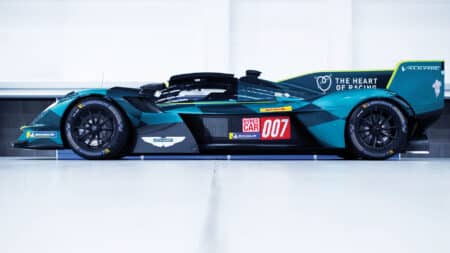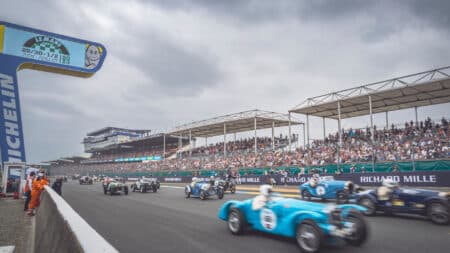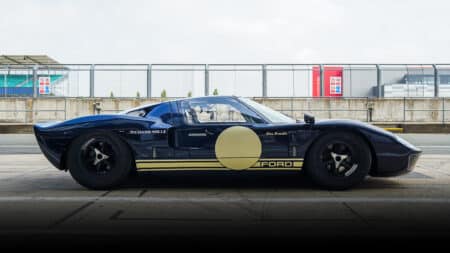
Aston Martin Valkyrie hypercar gallery: Racing's most beautiful car
Monstrous yet beautiful, the Aston Martin Valkyrie is fighting its way up the sports car field with a screaming V12 – here's our exclusive photoshoot with the car
Who do you think was more satisfied with their Le Mans weekend, Toyota or Nissan?
On first glance, this is a question not requiring a serious answer. Sure, Toyota was unable to match the runaway pace of the Porsches and Audis that turned the 83rd running of the Le Mans 24 Hours into a race of two brands, both owned by a third, but both TS040s ran reliably from flag to flag to finish in sixth and eighth position.
By contrast and despite fielding 50 per cent more cars, just one NISMO GT-R LM struggled across the line, bog last not just in its class, but the race itself, and so far down it wasn’t even classified as a finisher. For a manufacturer with a Le Mans history it was surely a humbling weekend and probably a humiliating one too?

Maybe. But let’s now apply just a little perspective, first to Toyota. It is the reigning sports car champion, a title won entirely on merit by dint of having the better car throughout the 2014 season. By all rights, Toyota should have won Le Mans last year but we know this race is no respecter of such considerations. This year Toyota didn’t merely fail to make a similar advances to those of its rivals, it appeared to have gone backwards.
Having claimed an imperious pole in 2014, this year in qualifying the Toyotas were a barely believable 6.7 and 6.9sec off the front-runner’s pace and nearly 2sec slower than last year, and while both would go faster in the race, neither troubled the region below 3min 20sec where all six Porsches and Audis were able to run at will. By the flag, even the faster of the Toyotas was eight laps off the lead. Over the course of 24 hours Toyota gave away better than the distance from London the Brighton to the leading Porsche. Reliability aside, positives must have been hard to find.
But what then of Nissan, which turned up and only just fulfilled its promise in qualifying to be quicker than the quickest LMP2 car, despite a powertrain with a reputed 1250bhp? Some 20 seconds off the pace, they were so slow they failed to manage a lap time within 110 per cent of the pole-sitter and were duly demoted to the back of the LMP grid to start in positions 30, 31 and 32.
On the track the Nissans looked awful, bobbing about on what looked like a substantially undeveloped chassis. They were so slow coming out of corners as their front-drive format struggled and largely failed to cope with their power that other ostensibly far slower cars would simply shoot past at the exit of the tracks many tighter turns. There seemed scarcely a moment when one of them wasn’t in some kind of trouble.

And yet for every person who hated the Nissan and regarded it as an insult to both the top category of the world’s greatest race but also the company’s history at Le Mans, so too was there someone else who loved the boldness of the design and the fact that someone was trying something completely and utterly different.
I am firmly in the latter camp. No the GT-R LM is no oil painting, but which LMP1 is? Actually I think it is beautifully ugly and of them all, the one I’d choose to look at. And I applaud both the rule makers and Nissan’s maverick British designer Ben Bowlby for making such a car possible. I think there should always be space for interesting and experimental cars at Le Mans and you need only look at the state Formula 1 finds itself in to know how dull racing car design and racing itself can become with an overly-proscriptive rule book.
Most of all though I think Nissan was being brave going to Le Mans. When Porsche announced its new LMP1 programme, it then waited three full years before actually racing the car. By contrast Nissan showed its contender to the world in February, actually with a plan to race it in April and May, which was put back to June following a failed crash test.
So Le Mans really was only ever going to be a test and anyone with higher hopes was frankly being naïve. But why even put yourself through that? Why not do what Porsche did and give yourself a few years’ development rather than risk making a fool out of yourself in public? Nissan, after all, can afford to.

But what it cannot do is test at Le Mans. There is no circuit like Le Mans and nowhere else you can go to simulate the unique challenge it poses and the stresses it places on your machinery. Even Paul Ricard, the most Le Mans-like of tracks thanks to its immense back straight, in no way equates to actually lapping Le Mans, a place where all front-running cars will accelerate from really very little to over 210mph four times every single lap.
As a data gathering exercise, its importance cannot be understated. I can remember back in 2001 the new Bentley team being far more interested in getting a car to the finish than going fast and falling out because of the value of the data, even back in those comparative technological dark ages.
Nissan now has that data, not to mention a core following of fans who feel instinctively well disposed towards a team prepared to do something different.
I have no idea whether the Nissan LMP1 car is the white elephant many consider it to be, or if it will come back next year and clobber an even more improved Porsche and Audi. I know 20sec a lap sounds like an impossible mountain to climb, but I know also that Nissan were not able to engage the car’s supplementary rear drive system and spent most of the race with the twin flywheel hybrid drive system (and therefore better than half its power) switched off, so there is at least hope. And for Nissan it just has to work because if a concept as radical as that turns out to be wrong, there’s no engineering your way out of it: you simply chuck it away and start again.

So Toyota or Nissan? On balance and crazy as it sounds, I think the Nissan team will have woken up on Monday morning with broader grins on their faces. For Toyota, Le Mans 2015 was a race to forget, for Nissan it was one to remember: its one stated aim was to get a car to the finish and this it achieved, earning itself a stack of fans and goodwill for the open, good-humoured way it went about its racing.
Next year however will be different: Nissan still won’t have to win, but it will have to be credible and I hope it is: one more team up the front will do an already superb show no harm at all. Besides I’ve always believed that fortune favours the brave and on that basis, a place among the Porsches, Audis and hopefully resurgent Toyotas is the least the team deserves.

Monstrous yet beautiful, the Aston Martin Valkyrie is fighting its way up the sports car field with a screaming V12 – here's our exclusive photoshoot with the car

It's the final day of racing at the 2025 Le Mans Classic. Watch the live stream here for coverage of the world's biggest historic race meeting

A final track test for Alex Brundle before heading to the 2025 Le Mans Classic: see how he fine-tunes the legendary Ford GT40 for La Sarthe, and hear how Jackie Oliver won the 1969 24-hour race in one of the cars

How to eke out maximum performance from the Ford GT40's V8 engine: join Alex Brundle as he prepares for the Le Mans Classic